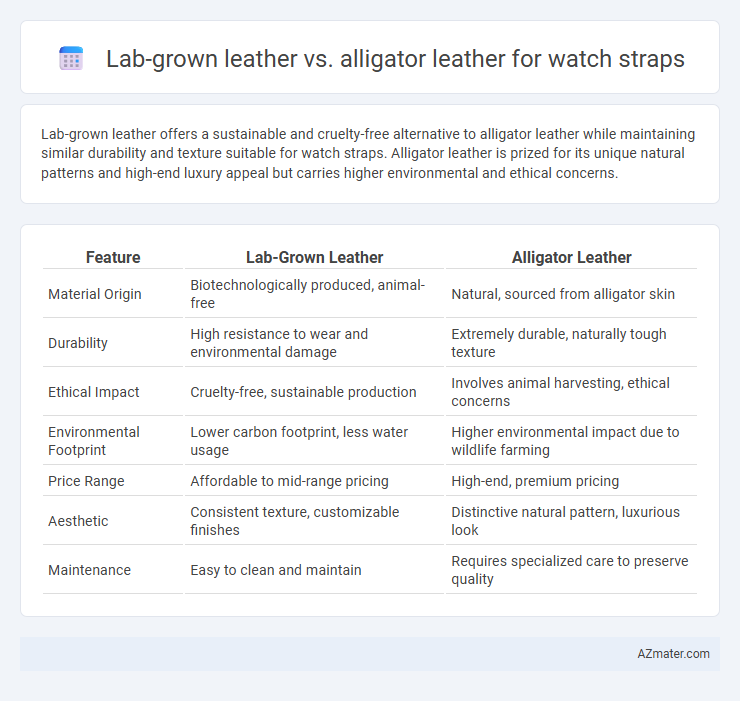Lab-grown leather offers a sustainable and cruelty-free alternative to alligator leather while maintaining similar durability and texture suitable for watch straps. Alligator leather is prized for its unique natural patterns and high-end luxury appeal but carries higher environmental and ethical concerns.
Table of Comparison
| Feature | Lab-Grown Leather | Alligator Leather |
|---|---|---|
| Material Origin | Biotechnologically produced, animal-free | Natural, sourced from alligator skin |
| Durability | High resistance to wear and environmental damage | Extremely durable, naturally tough texture |
| Ethical Impact | Cruelty-free, sustainable production | Involves animal harvesting, ethical concerns |
| Environmental Footprint | Lower carbon footprint, less water usage | Higher environmental impact due to wildlife farming |
| Price Range | Affordable to mid-range pricing | High-end, premium pricing |
| Aesthetic | Consistent texture, customizable finishes | Distinctive natural pattern, luxurious look |
| Maintenance | Easy to clean and maintain | Requires specialized care to preserve quality |
Introduction to Lab-Grown and Alligator Leather Watch Straps
Lab-grown leather watch straps offer a sustainable and cruelty-free alternative to traditional materials, providing durability and a similar aesthetic to animal leather with advanced biofabrication techniques. Alligator leather watch straps are prized for their unique texture, natural patterns, and luxurious appeal, often enhancing high-end timepieces with their exclusivity and rich heritage. Both options cater to different market demands, balancing innovation and tradition in luxury watch accessories.
Manufacturing Process: Lab-Grown vs Alligator Leather
Lab-grown leather for watch straps involves a sustainable biotechnological process where collagen is cultured from animal cells and assembled into leather-like material, significantly reducing environmental impact and resource use compared to traditional methods. Alligator leather requires a labor-intensive process starting from live animal farming, followed by tanning and finishing, often involving chemicals harmful to ecosystems. The lab-grown method offers scalable, ethical production with consistent quality, while alligator leather remains prized for its natural texture and durability despite its intensive manufacturing footprint.
Ethical Considerations in Leather Sourcing
Lab-grown leather offers a sustainable alternative to alligator leather by eliminating the need for animal farming, thereby reducing environmental impact and promoting animal welfare. Alligator leather, while luxurious and durable, raises ethical concerns due to the exploitation and potential endangerment of reptile populations. Choosing lab-grown leather supports cruelty-free and environmentally responsible sourcing practices vital for ethical fashion.
Environmental Impact: Sustainability Comparison
Lab-grown leather for watch straps significantly reduces environmental impact by minimizing deforestation, water usage, and greenhouse gas emissions compared to traditional alligator leather, which involves farming and hunting practices that threaten biodiversity and consume large resources. Alligator leather production generates substantial waste and relies on chemicals that contribute to pollution, whereas lab-grown leather employs sustainable processes with lower carbon footprints and less toxic byproducts. The shift towards lab-grown leather supports circular economy principles, offering a more eco-friendly option for luxury watch strap manufacturing.
Durability and Longevity of Watch Straps
Lab-grown leather watch straps offer consistent durability due to their engineered uniformity, resisting wear, cracking, and moisture damage better than traditional leathers. Alligator leather, prized for its natural toughness and distinctive texture, provides exceptional longevity when properly maintained but is more susceptible to environmental stress and requires regular conditioning. For long-term usage, lab-grown leather ensures steady performance with minimal upkeep, while alligator leather combines luxury with durability, demanding attentiveness to preserve its lifespan.
Texture and Appearance: Visual Differences
Lab-grown leather offers a smooth, consistent texture with uniform grain patterns that can be customized to mimic various traditional leathers, providing a sleek and polished appearance for watch straps. In contrast, alligator leather showcases naturally occurring scales with unique raised patterns and a glossy finish, giving each strap a distinctive, luxurious look that highlights its organic origin. The visual differences lie in the uniformity of lab-grown leather versus the individualized, tactile richness of genuine alligator leather.
Comfort and Wearability on the Wrist
Lab-grown leather offers superior breathability and flexibility compared to alligator leather, resulting in enhanced comfort during extended wear on the wrist. Its consistent texture adapts better to wrist movements, reducing stiffness and preventing irritation commonly experienced with alligator leather straps. While alligator leather boasts durability and a distinct pattern, lab-grown alternatives excel in lightweight wearability and moisture resistance, making them ideal for everyday use.
Pricing and Market Availability
Lab-grown leather watch straps typically cost 30-50% less than alligator leather, making them a more affordable yet sustainable option. Alligator leather remains a luxury choice with prices ranging from $200 to over $500 per strap due to limited supply and labor-intensive craftsmanship. Market availability of lab-grown leather is expanding rapidly as innovative brands and manufacturers increase production capacity, whereas alligator leather is restricted by environmental regulations and ethical concerns, limiting its widespread availability.
Maintenance and Care Requirements
Lab-grown leather watch straps require minimal maintenance, typically needing only occasional cleaning with mild soap and water to preserve their appearance and flexibility. Alligator leather watch straps demand more intensive care, including regular conditioning with specialized leather treatments to prevent drying, cracking, and color fading. The durability of alligator leather is high, but improper maintenance can significantly reduce its lifespan, whereas lab-grown leather offers consistent performance with less upkeep.
Future Trends in Watch Strap Materials
Lab-grown leather is emerging as a sustainable and customizable alternative to traditional alligator leather for watch straps, offering consistent quality without the environmental impact of exotic animal farming. Innovations in biofabrication and materials science are driving the development of lab-grown leather with enhanced durability, breathability, and texture tailored specifically for luxury watch straps. Future trends indicate a shift toward eco-friendly, cruelty-free materials like lab-grown leather, as consumer demand for ethical luxury and advanced performance materials continues to rise in the horology industry.

Infographic: Lab-grown leather vs Alligator leather for Watch strap
 azmater.com
azmater.com